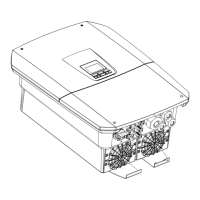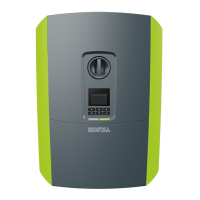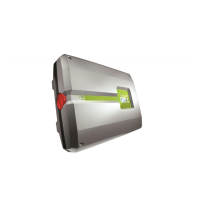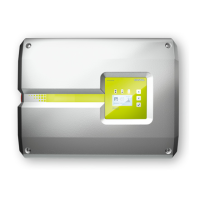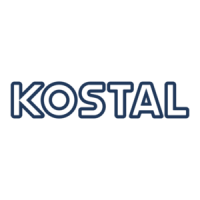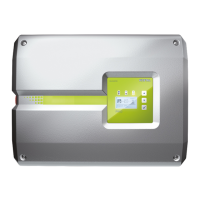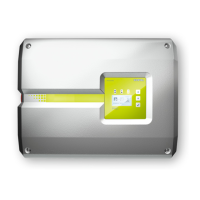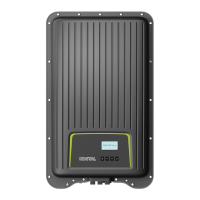Do you have a question about the Kostal PLENTICORE plus and is the answer not in the manual?
Defines intended use, operational limits, and safety precautions for the inverter.
Lists directives and standards the inverter complies with for market availability.
Explains the manual's purpose, target audience, scope, and how to use it effectively.
Explains warning, information, and other notes, including symbols and their meanings.
Defines the various symbols and abbreviations used throughout the manual for clarity.
Explains the meaning of signs and labels applied to the inverter housing for safety and identification.
Illustrates a typical PV system setup, showing connections between inverter and other components.
Describes the external components and physical layout of the inverter unit.
Explains the energy management system and how the inverter handles energy flows.
Provides guidelines for safely transporting, handling, and storing the inverter before installation.
Lists all items included in the inverter packaging, ensuring all necessary components are present.
Details criteria for selecting an appropriate installation location, considering environmental and safety factors.
Explains the procedures for connecting the inverter to the electrical grid and other system components.
Details the step-by-step procedure for activating the inverter and bringing it into operation.
Explains the safe procedure for turning off the inverter's feed-in to the public grid.
Describes essential steps to de-energize the inverter for safe maintenance or work on components.
Explains the inverter's control panel, including display elements, buttons, and status LEDs.
Explains how to interpret the inverter's operational status notifications shown on the display.
Explains the meaning of the different LED indicators on the inverter for status and fault reporting.
Describes the inverter's screensaver function and the hierarchical structure of its menu system.
Explains methods for connecting the inverter to a computer via LAN or WLAN for configuration.
Details necessary network configuration settings on a Windows 10 computer for inverter access.
Outlines the procedure for safely disconnecting the computer from the inverter after use.
Explains how to use the KOSTAL (PIKO) Solar App for remote monitoring of PV systems.
Introduces the Webserver as the graphical interface for inverter management and its start screen.
Explains how to access the inverter's Webserver using a web browser and login procedures.
Details the hierarchical structure of the Webserver menus, covering Home, Current Values, and Statistics.
Lists and describes the functions available within each menu of the Webserver interface.
Explains the data logged by the inverter, its structure, and its usefulness for system analysis.
Describes methods for downloading, saving, and graphically depicting log data for analysis.
Details the features and prerequisites for using the KOSTAL (PIKO) Solar Portal for system monitoring.
Explains how remote service technicians can access and diagnose the inverter for troubleshooting.
Explains why active power control is used and describes the two main types of implementation.
Details how to set PV feed-in limits according to energy provider regulations via inverter menus.
Explains how to implement active power control using a ripple control receiver connected to the inverter.
Describes active power control implementation using smart meters and gateways for grid regulation.
Provides an overview of the self-consumption configuration, including components and basic setup.
Details the electrical wiring and connection steps for implementing self-consumption control.
Explains how to configure self-consumption control functions via the Webserver interface.
Outlines the routine maintenance tasks and intervals required to keep the inverter in optimal condition.
Provides instructions for cleaning the inverter's external housing using a damp cloth.
Details the step-by-step procedure for safely disassembling, cleaning, and reassembling the inverter fans.
Explains how to update the inverter's software to the latest version using the Webserver.
Lists and explains inverter event codes, their causes, and recommended measures for resolution.
Presents detailed technical data for the inverter, including input/output parameters and device properties.
Shows a block diagram illustrating the inverter's internal components, signal flow, and connections.
Describes the KOSTAL (PIKO) Solar Portal for remote monitoring of PV system operation via the internet.
Explains the features and usage of the KOSTAL (PIKO) Solar App for monitoring PV systems on mobile devices.
Details the PIKO M2M Service for continuous, secure system monitoring via a mobile link to the solar portal.
Explains how to purchase an activation code and connect a battery to the inverter's third PV input.
Explains the identification details and technical data listed on the inverter's type plate.
Provides details on the inverter's warranty period, registration benefits, and service contact information.
Lists essential points to cover when handing over the commissioned system to the operator.
Details procedures for safely disassembling the inverter and proper disposal of electronic waste.
| Model | PLENTICORE plus |
|---|---|
| Type | Hybrid Inverter |
| Number of MPP Trackers | 3 |
| Battery Compatibility | Yes |
| Protection Class | IP65 |
| Maximum DC Input Voltage | 1000 V |
| AC Output Frequency | 50/60 Hz |
| Operating Temperature Range | -25°C to +60°C |
| Cooling | Natural Convection |
| Communication Interfaces | Ethernet |
| Nominal AC Output Voltage | 230 V |

